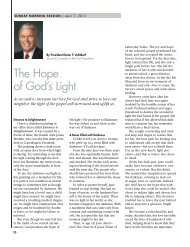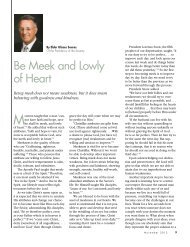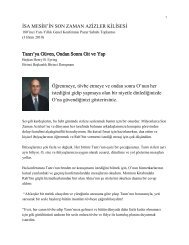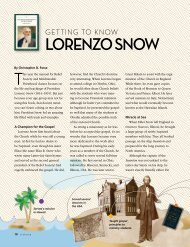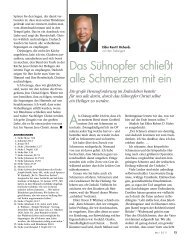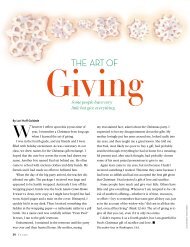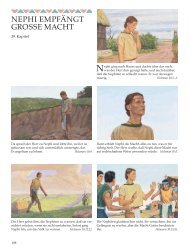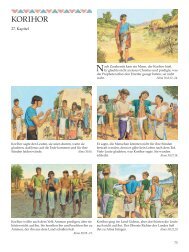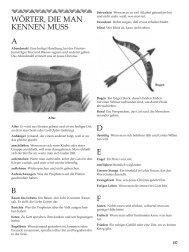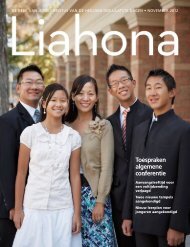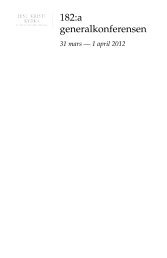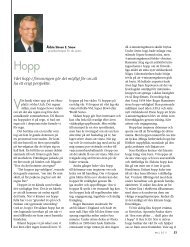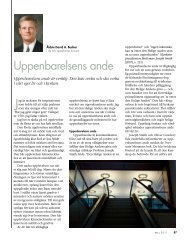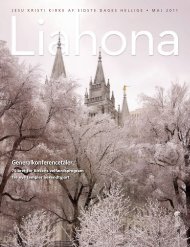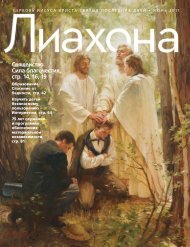July 2004 Ensign - The Church of Jesus Christ of Latter-day Saints
July 2004 Ensign - The Church of Jesus Christ of Latter-day Saints
July 2004 Ensign - The Church of Jesus Christ of Latter-day Saints
You also want an ePaper? Increase the reach of your titles
YUMPU automatically turns print PDFs into web optimized ePapers that Google loves.
70<br />
become Salt Lake City radio station KSL. It struck<br />
him that an emerging technology—network<br />
radio signals—could be used for a musical broadcast<br />
featuring the Tabernacle Choir and organ.<br />
Brother Glade convinced the choir, and the first<br />
broadcast aired on 15 <strong>July</strong> 1929 to 30 stations.<br />
<strong>The</strong> scene was somewhat different from the<br />
highly technical and frenzied pace <strong>of</strong> to<strong>day</strong>’s<br />
broadcasts. On a Mon<strong>day</strong> afternoon the choir<br />
gathered in the Tabernacle under the direction<br />
<strong>of</strong> Anthony Lund. A single microphone was<br />
strung from the ceiling, and a tall ladder was<br />
placed beneath it. Nineteen-year-old Ted<br />
Kimball, son <strong>of</strong> Tabernacle organist Edward P.<br />
Kimball, climbed the ladder to announce the<br />
songs. He stayed on his perch for the entire<br />
broadcast. <strong>The</strong> starting time cue was<br />
telegraphed in from New York City, and the<br />
broadcast was a success. Music and the<br />
Spoken Word was set in motion.<br />
In June 1930 Richard L. Evans was<br />
named the <strong>of</strong>ficial announcer. <strong>The</strong> broadcast,<br />
which started on NBC, was picked up by<br />
the CBS Radio Network, which still carries it<br />
to<strong>day</strong>. <strong>The</strong> voice <strong>of</strong> Brother Evans, who became<br />
Elder Evans with his calls to the Seventy and<br />
later the Quorum <strong>of</strong> the Twelve Apostles, rang<br />
out for 41 years on Music and the Spoken Word.<br />
He became a household name, and some not <strong>of</strong><br />
his faith claimed him as their spiritual leader.<br />
“I belong to the Richard L. Evans church,”<br />
one elderly gentleman told missionaries who<br />
knocked on his door. Robert D. Monson <strong>of</strong><br />
Ogden, Utah, was one <strong>of</strong> those elders. “We<br />
could not convince him that the church we represented<br />
and the church <strong>of</strong> Richard L. Evans<br />
were one and the same,” Brother Monson wrote in<br />
a letter to the choir. “After repeated attempts to convince<br />
him, we presented him a copy <strong>of</strong> the Book <strong>of</strong> Mormon and<br />
parted friends.”<br />
Top: <strong>The</strong> choir in front<br />
<strong>of</strong> the Tabernacle, 1926.<br />
Right: A choir member’s<br />
dress from 1965; a cape<br />
that was once part <strong>of</strong><br />
a conductor’s outfit;<br />
a dress from 2001.<br />
Above: A historic sketch<br />
<strong>of</strong> the choir’s first radio<br />
broadcast. Right: Elder<br />
Richard L. Evans <strong>of</strong> the<br />
Quorum <strong>of</strong> the Twelve<br />
Apostles, long time<br />
announcer for the choir.<br />
Far right: One <strong>of</strong> the<br />
choir’s early records,<br />
and a magazine cover<br />
featuring the choir at the<br />
1965 U.S. presidential<br />
inauguration.



